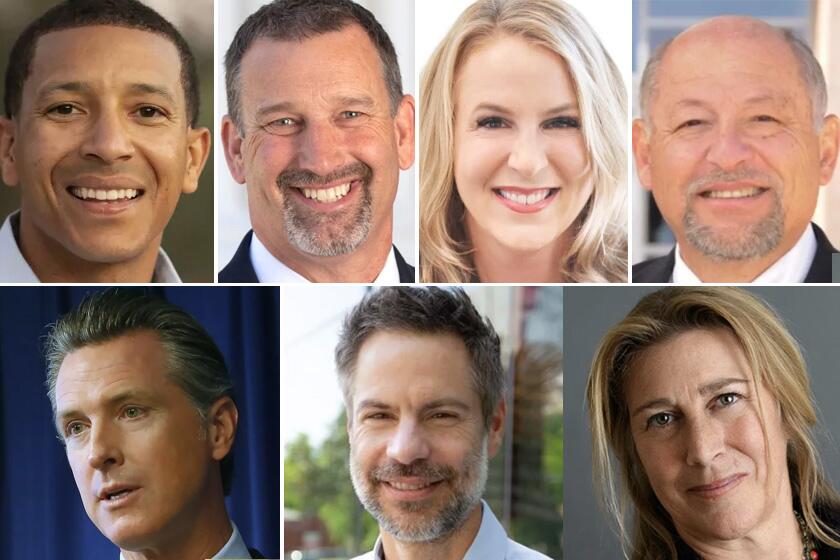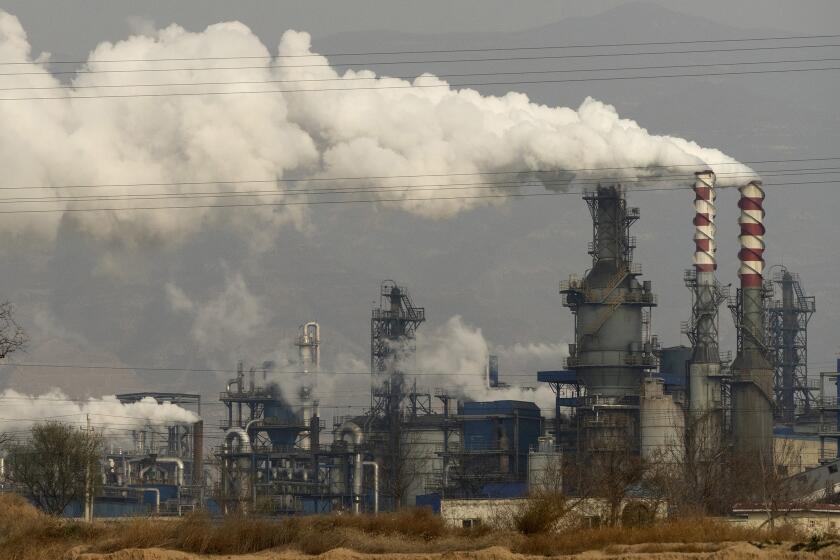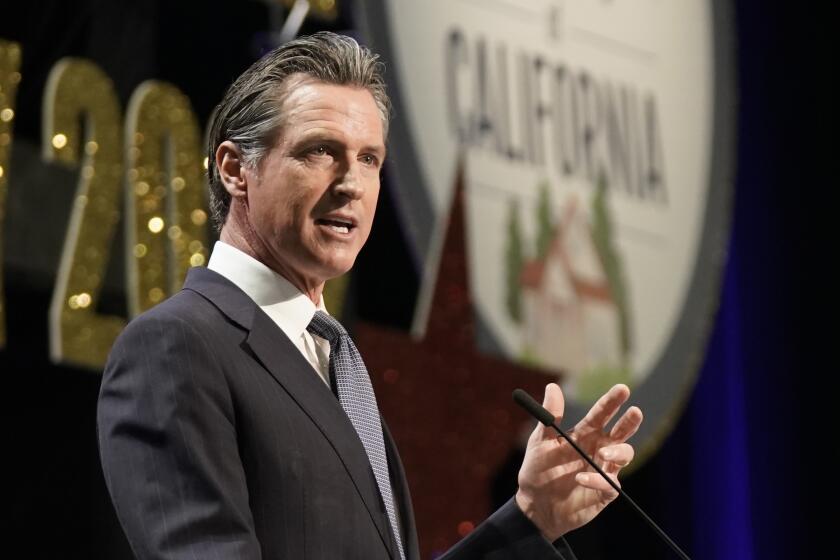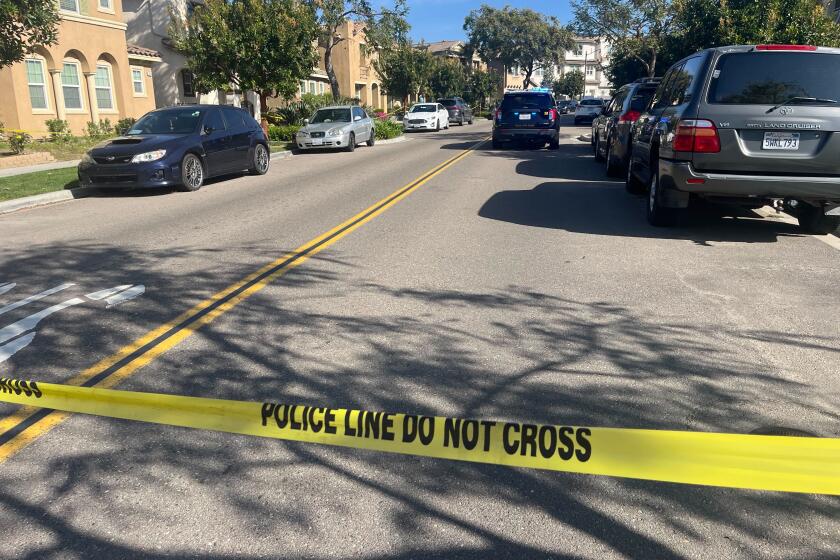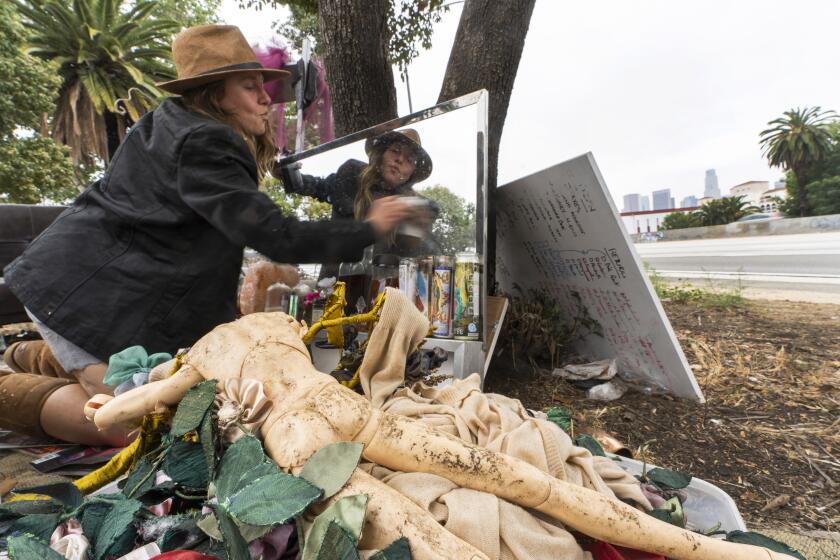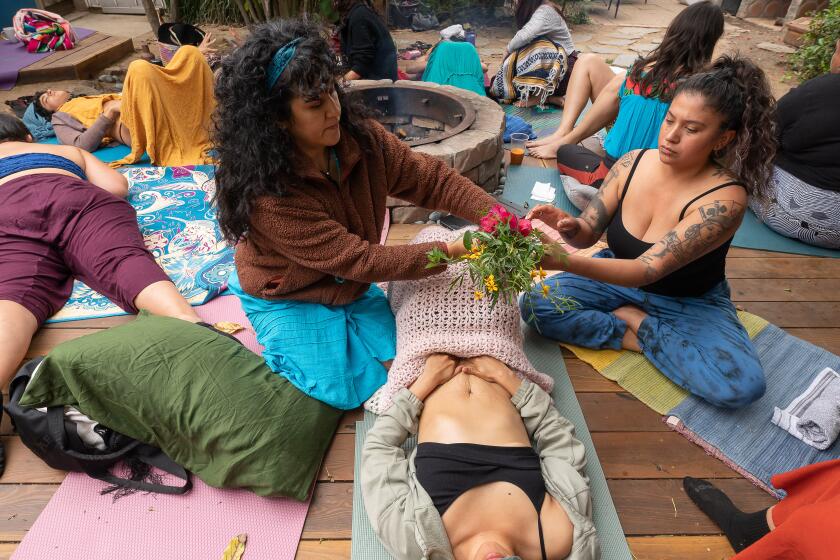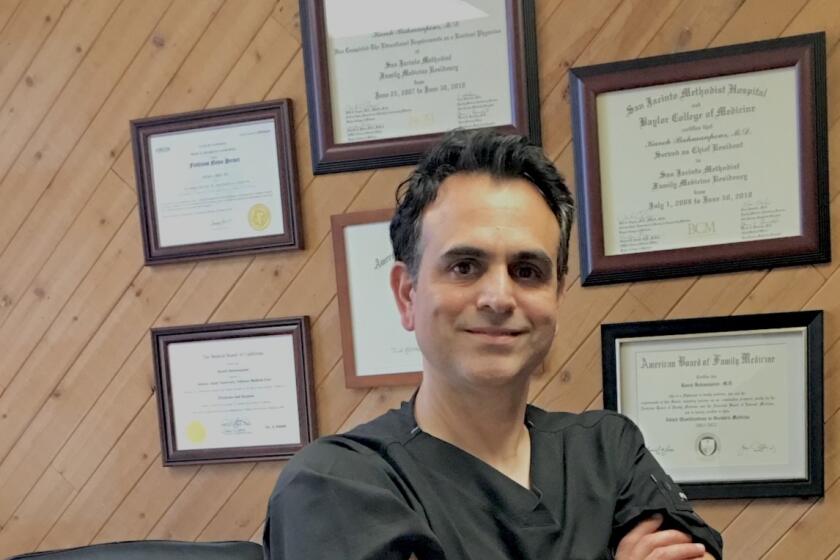2022 election: Q&A with David Lozano, California gubernatorial candidate
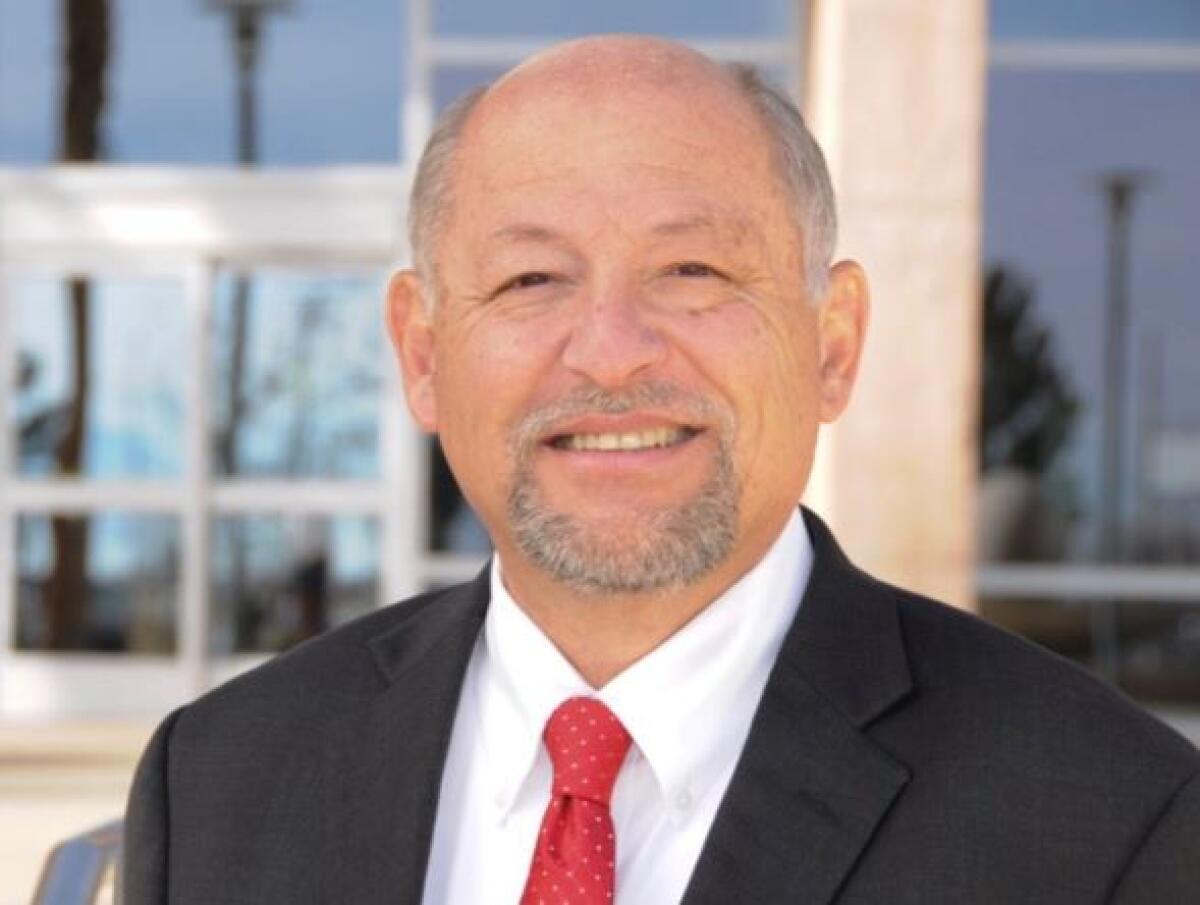
After easily surviving a recall last year, Gov. Gavin Newsom is expected to cruise to re-election. The only question in the June 7 gubernatorial election is who will be the the second highest vote-getter and make the Nov. 8 runoff with him. We are publishing Q&As from Newsom, a Democrat who has raised $7.5 million for his campaign, and six of his seven challengers who have raised more than $80,000 for theirs. One didn’t respond to our requests.
None of the other candidates have amassed anything close to Newsom’s haul. Here are the candidates who responded to us, and their fundraising totals so far: Republican Sen./farmer Brian Dahle ($1.5 million); Republican entrepreneur/mom/businesswoman Jenny Rae Le Roux ($847,000), independent homelessness policy advocate Michael Shellenberger ($661,000), Republican military officer/attorney Shawn Collins ($240,000), independent former Nevada City mayor Reinette Senum ($121,000) and executive officer/attorney David Lozano ($80,000).
If you have comments or questions about the election or any of the candidates after reading this interview, please email Editorial and Opinion Director Matthew T. Hall at matthew.hall@sduniontribune.com.
Below are David Lozano’s responses and a link to other responses.
Q: Housing affordability has been a central focus for state lawmakers for years, yet home prices and rents are soaring, and investor speculation is greater than ever. How do you address this?
A: Making housing affordable for middle class and low income families is one of my top issues since I announced my candidacy for office. As governor, I would immediately ease state regulations that impose huge costs on housing construction and regulations that stop and/or delay projects and discourage the building of low-priced rental properties. Local officials need to ease zoning and other building regulations, especially in high demand areas that prevent much needed construction of new housing projects or that prevent the conversion of old buildings into residential housing. Entrepreneurs should be encouraged to enter housing markets across the state to provide creative and low-cost solutions to meet consumer demands for housing, thereby eliminating the government-created shortage.
But my specific solutions and innovative ideas come from my 28 years as a federal attorney where I have been fighting the mortgage industry and saving people’s homes from foreclosure. Through these experiences, I have been able to develop a revolutionary program that will allow homeowners to invest in a home that they not only will be able to easily afford the monthly payments, but they will be guaranteed a profitable return on their investment and all contained within a 20-year mortgage loan. Go to lozanoforcalifornia.com and you will discover my plans for affordable housing as it relates to the thousands of Californians who will be moving into the three new state-of-the-art commercial and residential cities that will be built in cooperation with the project called “A New Hope.”
After easily surviving a recall last year, Gov. Gavin Newsom is expected to cruise to re-election.
Q: Homelessness has exploded statewide despite unprecedented attention and state aid. What should the state be doing that it isn’t? What’s working and what is not working?
A: I am the only gubernatorial candidate who has a detailed plan to resolve homelessness for the entire state of California. It is called “A New Hope.” The basis of my solution comes from the already successful program out of Finland, called “Housing First.” Many people may not know that Finland has almost solved its entire homeless problem. I have taken the best parts of that program, brought it here to the U.S. and reworked it, adding hundreds of my own ideas specifically for California, and my project is now ready to be implemented. What this means is that every homeless person, whether they are drug-addicted, alcoholic, mentally ill or financially destitute who today lies on our streets, sidewalks and park benches, in our tents, along our beaches and under our bridges will be housed, fed, cared for and rehabilitated — all 160,000 — in hopes of returning one day back to society. And for those who do not wish to return back to society, we have a place, a community for them as well, and I can do all of this within two years or less. Yes, I know it sounds impossible, but it is true. And i can prove it! Go to lozanoforcalifornia.com to watch my video and read the details of “A New Hope.”
Q: How would you address concerns about rising crime overall? What do you feel about current efforts to revise criminal justice reform laws like Propositions 47 and 57? What changes would you support?
A: I am the only gubernatorial candidate with a prior law enforcement background, having been a Los Angeles deputy sheriff in the late 1970s and early 1980s, patrolling out of the infamous sheriff’s station known as Lennox in the center of Watts in South Central Los Angeles, and I am the only candidate with 28 years experience as a federal attorney, which gives me the skill, knowledge and background to know exactly what is needed to address, handle, manage and wipe out the crime infestation that has taken over California.
For instance, the public thinks that Proposition 47 is only about the theft of merchandise totaling less than $950 to be a misdemeanor, allowing criminals to go into stores and commit grab and run crimes. But this is not the case. The truth is what really happened when Proposition 47 became law was that it took away the ability for prosecutors to decide whether or not to charge criminal offenders under felony or misdemeanor charges based on their past criminal history. What this means is that repeat offenders can immediately return to the streets without receiving proper sentencing or serving time. (My answer regarding Proposition 57 can be found below under another question due to space constraints.)
Q: How did Gov. Gavin Newsom handle the COVID-19 pandemic and how would you manage a pandemic as governor?
A: I personally believe that questions such as these, “What would I have done ‘if” ... ?” are somewhat “loaded” because the people asking these questions now have the advantage of knowing what others did not, and therefore have seen what actually worked and what didn’t work.
What I can say is I would not have done anything Newsom did. First, I would not have closed the churches — ever. Second, I would have done everything within my power to ensure that every hospital, health care facility, medical clinic and anything resembling a medical facility would have been fully stocked with supplies, inventory, equipment, food, tools and materials to handle a pandemic for well over a year. Third, I would have brought in doctors, nurses, licensed vocational nurses, nurse assistants and care providers from everywhere out of retirement or military retirement from other states and other countries in foresight for what could be expected. Fourth, I would have prepared the public. There is nothing wrong with preparation because if nothing happens — fine! At least we were prepared. Fifth, I would have never have closed down any California businesses. In fact, I would have done everything I could to have kept the businesses open and producing more — to generate more for the entire nation if not the world because both the nation and the world needed it — and certainly our California workers needed it — and I would have been right!
Q: California is running record budget surpluses at the same time many of its 39 million residents are struggling to make ends meet. What do you say to people who are frustrated by this picture?
A: What do I say? Elect me. Vote for me and I can change California. For years people of California have been voting for movie stars, radio disc jockeys and Olympic athletes. Heck, I was at a luncheon last week and a young lady at the table told me her grandmother voted for the last governor because she thought he was cute. The other woman at the table said her mom voted for Newsom because she liked the way he dressed. Come on, California! Please! Look at my background — look at what I have accomplished and what my solutions are. I was a past cop working the streets of Los Angeles for years, I’ve worked the jails in Los Angeles. How many past governors have that experience? I’ve been a federal attorney specializing in finance, fighting against the mortgage industry for the past 28 years. I can solve homelessness and crime. I can lower taxes, provide affordable housing to lower and middle class families, and bring industrial arts and trade skills back to our high schools. I can reinstitutionalize mental health facilities all throughout California. I can provide health care and housing for our veterans. I can bring water management to our state. I can do all of this because I have the skill, training, knowledge, ability and determination to make this state great again. Now personally I do think my ties are OK, but my wife did say I could get a few more trendy looking suits.
Q: An estimated 2 million undocumented people live in California with about 1.1 million of them in the workforce. What would you say to them about their future?
A: First, none of these 2 million undocumented people can vote — as they are noncitizens. And voting for a representative of the people is one of the ways in which we have our voices heard and get matters in this country accomplished.
However, America needs hardworking, legal immigrants. California needs the same. And I believe the majority of these 2 million people are hardworking, honest people who came into this country to find work and raise their families and would fight to defend this country.
But they must understand that they have to follow our laws and abide by our rules and regulations, and therefore they must enter this country legally and properly in order for us to screen and process them appropriately for a variety of reasons. Two of those reasons are to protect our citizens and the welfare of this country.
Fortunately, I have an incredible solution to resolve this problem of not having entered properly and therefore these immigrants must reenter legally with the appropriate documentation. Therefore, I ask that they tell their family and friends who are registered to vote for David Lozano so that I can execute my solution to work with our federal government to implement new immigration policies that will result in the acceleration and expedition of these procedures so that California can welcome these immigrants legally into our state to work and raise their families.
Q: What do you consider the state’s most pressing concern related to climate change and how would you address it?
A: Although sea level rise, coastal flooding, coastal erosion and greenhouse gas emissions all have a link to climate change, it is my opinion that high temperatures and drought are California’s current and most pressing concerns related to climate change as these two conditions are likely to increase the severity, frequency and extent of wildfires that could harm property, livelihoods and human health. Public perception of this position would agree with me in that the warming climate is intensifying California’s drought conditions and threatening its snowpack. The current drought is leading to stressed ecosystems, depleted reservoirs, hard-hit farms and rural communities, and threats to urban water supplies. Research suggests that around 2,700 wells could go dry this year in the Central Valley and nearly 1,000 more next year if dry conditions persist.
The solution is to immediately implement all remedies of water supply, such as drilling, pipelining, desalinization, conservation, reclamation, diversion, etc., instead of choosing one plan over another due to various factors such as delays because of oversight committees involving cost-saving plans, construction problems, time delays or which project to choose from. Choosing an “all plans solution” will provide California the water it desperately needs the fastest way possible.
Q: What, if anything, can the state do to make clean transportation options — such as bicycles, buses, trains, and electric vehicles — affordable, feasible and desirable? What would you do?
A: Clean transportation describes the development of alternative fuels and advanced transportation technologies and the expansion of traditional public sector transportation services that result in lower emissions, greater efficiency of transportation per unit of energy, or a more accessible and usable transportation system. Walking is the first mode of transportation, the most sustainable — and the most healthy. European towns, as many towns around the world, were designed with that mode in mind, and exemplify this thinking and philosophy. It’s a theory that we in America need to consider when designing our future cities. Public transport would be second, although Californians have come to love their independence and their safety within their own vehicle. And although it is easy to say electric vehicles are the wave of the future, I still hold reservations on the end results of the lithium batteries that these electric vehicles rely on and the potential harm to our environment due to the mining for raw materials such as cobalt, lithium, manganese, nickel and other materials used to build electric car batteries.
Q: Public schools face declining enrollment, teacher shortages and a continuing achievement gap. How would you improve public education and ensure equity for all students?
A: Ensuring equity in education is a necessary component in narrowing the achievement gap. Teachers and school leaders ensure equity by recognizing, respecting and attending to the diverse strengths and challenges of the students they serve. High-quality schools are able to differentiate instruction, services and resource distribution to respond effectively to the diverse needs of their students, with the aim of ensuring that all students are able to learn and thrive. I have read countless articles and books, and attended meetings, conferences and lectures on this subject. There are great suggestions, such as engaging students, families and communities as full partners, diversifying the educator workforce, developing inclusive discipline and dress code policies.
Heck, there are a thousand ideas and suggestions. How about just sitting down and listening to teachers and giving them 100 percent support for what they to get their job done? If they need two or three teachers aides in the room, give it to them. If they need materials or books or pencils or whatever, give it to them. If they need food for the kids, give it to them. If they need after-school tutoring. Darn it, give it to them. We need to support all our schools and our kids and our kids’ families.
Q: According to the California Department of Water Resources, agriculture accounts for about 80 percent of all the water used in California. Should California consider limiting or banning water-intensive crops like almonds and alfalfa? If so, explain why and how. If not, explain what you would do to address a historic drought.
A: New and innovative water infrastructure and aggressive and powerful water management, this is how as governor I would address the historic drought problem in California. In California, there will always be droughts. And even in good years, there will never be quite enough water to satisfy the demands of the state’s urban population, its natural environment and an insatiable $50 billion agriculture industry. Remember that 20 percent of the state’s water supply goes to the state’s population while 80 percent goes to agriculture. To put the blame on the almond or alfalfa growers is just a little one-sided. And although we can make substantial offers to these farmers to move to other states, their overall impact would not truly make a dent in preserving the water needed to solve California’s drought problem.
We need to make permanent, substantial changes to our water infrastructure and our water management by seeking out and implementing all of the new and innovative ideas that science and technology have to offer, at whatever price it currently costs. Because the price is not going to go down, and the longer we wait, the worse the problem is going to get.
Q: What would be another top priority for you, other than the ones you have discussed above?
A: I don’t have another topic, I just wanted to complete the answer from the question above regarding Proposition 57.
California voters passed Proposition 57 in 2016 as a reform measure giving nonviolent inmates a chance at early parole. The measure was of course sold heavily on the idea that our prisons were overcrowded, the financial savings to the taxpayer would be in their best interest, etc. As of March 2020, however, only 20 percent had been paroled as state judges have ruled that the state prison system isn’t complying with the law’s intent and, as such, most of these inmates have now sued the state to enforce their early release, costing the taxpayers even more money.
Bottom line, we had a sentencing system in place. Why was a system that was already structured changed? And who wanted it changed? If it hadn’t been changed, these criminals would still be incarcerated, still serving their sentences, no further litigation cost would now be charged to the taxpayer, and fewer criminals would be on the street.
Get Weekend Opinion on Sundays and Reader Opinion on Mondays
Editorials, commentary and more delivered Sunday morning, and Reader Reaction on Mondays.
You may occasionally receive promotional content from the San Diego Union-Tribune.
